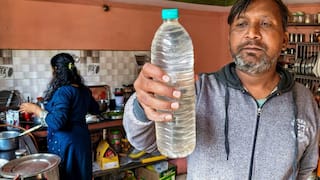Decoding National Logistics Policy. How Will It Contribute To Govt’s Ease Of Doing Business
On September 17, Prime Minister Narendra Modi in New Delhi launched the National Logistics Policy that aims to reduce the cost of logistics from the existing 13 per cent-14 per cent

In a bid to promote seamless movement of goods across India and improve the competitiveness of products in domestic as well as global markets, the central government rolled out the National Logistics Policy (NLP) in September. The policy aims to reduce the cost of logistics from the existing 13 per cent-14 per cent, which in turn will immensely contribute to the government’s ease of doing business initiative.
On September 17, Prime Minister Narendra Modi in Vigyan Bhawan, New Delhi, launched the National Logistics Policy. During his address, Modi said the NLP is a comprehensive effort to enhance the efficiency of the logistics ecosystem as India is fulfilling big export targets and emerging as a manufacturing hub. "The National Logistics Policy will bring new energy in all sectors. For the country to become globally competent, there is a need to charge up efforts, efficiency and improve productivity," the prime minister said, while hailing India’s emergence as the world’s fifth-largest economy.
What Is National Logistics Policy?
The National Logistics Policy is a comprehensive effort to address cost and inefficiency by issues laying down an overarching interdisciplinary, cross-sectoral, and multi-jurisdictional framework to develop the entire logistics ecosystem in the country.
Key Takeaways
- There will be digital integration of different systems of some departments such as road transport, railways, aviation, commerce ministries, and foreign trade
- This ensures shorter and smoother cargo movement and enables the exchange of information confidentially on a real-time basis
- This National Industrial Corridor Development Corporation Logistics Data Bank Project has been leveraged
- Ease of Logistics will enable and ensure the ease of logistics business through transparency and accessibility
- System Improvement Group will monitor all logistics-related projects regularly
Boost to GatiShakti
Commerce and Industry Minister Piyush Goyal pointed out the merits of PM's National Master Plan or GatiShakti working in conjunction with the new National Logistics Policy. He said that there are as many 900 data layers available in India and the process of de-layering has begun for ease of doing business and cutting through bottlenecks. Look at the layers available - from transmission lines to telecom towers, from rivers to railways lines, from highways to wildlife sanctuaries, one has to rapidly scale up and create a robust system that reduces costing, planning, designing, tendering and monitoring by filling in the gaps.
Goyal cited example of JNPT which for years has been grappling with last mile connectivity issues. Now such logjams will be resolved by optimally utilising these data layers. Cement companies for instance are positive on GatiShakti as they have major last mile connectivity issues.
Is NLP Beneficial?
NLP is envisaged to bring efficiency in logistics services and human resources through streamlining processes, regulatory framework, skill development, mainstreaming logistics in higher education and adoption of suitable technologies. The vision is to develop a technologically enabled, integrated, cost-efficient, resilient, sustainable, and trusted logistics ecosystem for accelerated and inclusive growth.
The introduction of initiatives such as, E-Logs (Ease of Logistics Services), ULIP will not only aid in reducing logistics costs, but also make processes paperless, while providing access to all essential data to key stakeholders.
Views Of India Inc
Flipkart Group Chief Corporate Affairs Officer Rajneesh Kumar said, "The National Logistics Policy is a welcome move and this along with PM Gati Shakti plan will help build a more resilient logistics ecosystem in the country. Along with improving efficiency across the value chain, it will also result in a considerable reduction in logistics costs from their present level, thereby benefiting the end customer with lower costs.” He said that the policy will also strengthen the demand for modern warehousing in the country, fast tracking India's journey to become a global logistics hub with enhanced economic activity post-pandemic and achieve global benchmarks by 2030 by removing hurdles within the logistics sector and organising it.
CEO and Co-founder of e-commerce-focussed Software-as-a-Service (SaaS) provider, FarEye, Kushal Nahata said that to make India as competitive as China, the US, and Europe, the government must bring down the logistics costs, which currently hovers around 13-14 per cent to nearly 8 per cent in the next 5 years. "The Unified Logistics Interface Platform (ULIP) not only promises to bring all the stakeholders on one platform but will also harness the power of data analytics to facilitate the seamless movement of cargo within the country. ULIP will bring in more visibility and transparency to the logistics sector and help companies become more cost-efficient," Nahata added.
SVP & Managing Director, Blume Global India, Sudhir Unnikrishnan said, “The new logistics policy opens new global avenues for technology companies like ours and we are happy with this welcoming move,” while adding, “In a country like India where road transport forms the backbone of logistics, an integrated infrastructure will enhance seamless connectivity across all modes of transportation. We also believe this will help in creating a more sustainable environment by providing an open, neutral platform across all trading partners. The combined aim of NLP and Gati Shakti is to bring logistics cost below 10 per cent and we completely agree that digitisation and ULIP will enhance cargo movement with better accessibility of the available data. Undoubtedly, a connected infrastructure will bring in better visibility, cost efficiency, skill development and a better tomorrow.”
A Road Map For Better Growth
India’s largest export market is the US, followed by the EU, the UAE, China, and the remainder of Asia. For the US and the UAE, jewelry is a key export good, for China commodity inputs, and for Europe, a mix of textiles, machinery, and pharmaceuticals. India’s imports have a very different geographical make-up: China is the largest supplier, having essentially replaced first the US (1990s) and then the EU (2000s, 2010s) as India’s main supplier, according to the 'Competitiveness Roadmap for India@100', released by The Economic Advisory Council to Prime Minister (EAC-PM).
The government has, under the Atmanirbhar Bharat Abhiyaan, provided production-linked incentives (PLI) to enhance Indian manufacturing capacity and exports in 10 sectors. India’s trade policy has become more focused on defending Indian companies from what is perceived as unfair competition on their home markets. India has become a frequent user of anti-dumping and countervailing duty policies, has introduced more preferences for domestic suppliers in its public procurement, and requires data related to Indian operations to be kept and processed in India.
Policy action focuses on the financing side, where the National Infrastructure Pipeline sets out ambitions for investment, and the Asset Monetization Pipeline (AMP) plans for raising private capital. PM GatiShakti, a National Master Plan for multi-modal connectivity, was announced in October 2021, identifying key infrastructure projects to be pursued as well as outlining a new institutional structure for a more integrated planning and execution process.
Through the implementation of NLP, India aims to be among the top 25 countries by 2030 in the Logistics Performance Index. As per World Bank Logistics Index of 2018, India is ranked 44th in logistics cost.
Related Video
India@2047 Summit: Modi Calls for Innovation, Reforms, and National Resolve
Top Headlines





































